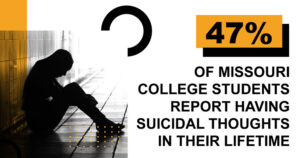 Here’s a daunting statistic about Missouri’s college students and mental health: one in four college students in the state have had suicidal thoughts in the past year. Upon hearing that, parents may turn a blind eye and say, “Yeah, but that’s not my kid.”
Here’s a daunting statistic about Missouri’s college students and mental health: one in four college students in the state have had suicidal thoughts in the past year. Upon hearing that, parents may turn a blind eye and say, “Yeah, but that’s not my kid.”
But the fact of the matter is, it could very well be your kid, which is why it is vital for college campuses to have easy access to the diverse mental health resources students need.
Enter Missouri’s Partners in Prevention Program, founded more than 20 years ago as an organization that addressed the negative consequences of alcohol use in college students. Today, Partners in Prevention has transformed into a coalition of 24 colleges and universities across the state that are dedicated to addressing healthier and safer campus environments. Partners in Prevention is funded by the Missouri Department of Mental Health, the Missouri Department of Health and Senior Services, and the Missouri Department of Transportation’s Highway Safety and Traffic Division. With grants, Partners in Prevention provides campuses technical assistance to analyze the current landscape and determine what each campus needs for its students. No campus is the same.
Joan Masters is the project director for Partners in Prevention and has been with the organization since its inception. “The issues students are facing on campus are very complex,” she says, “and they are experiencing trauma and serious mental health struggles (which could have come forth pre-college) that could lead to suicide.”
According to Partners in Prevention, 47 percent of Missouri college students report having suicidal thoughts at some point in their lives; 25 percent report having suicidal thoughts in the past year, with 2.1 percent attempting suicide. Fifty-eight percent of students who report having suicidal thoughts or who attempted suicide in the past year have not sought assistance. Students are also experiencing sexual violence on campus and are witnessing perpetrated acts of violence, but they don’t necessarily have the tools and knowledge yet to intervene in those situations.
“What we know is that on every campus, there are students experiencing trauma and struggling with mental health,” says Joan. “They are self-medicating with substances that are either illegal or not prescribed by their doctor, which is not solving their problems.”
 For parents, it is so important to prioritize kids’ mental health just as you would physical health, and normalize seeking out help. Parents must look out for and care about all aspects of their child’s mental health in order to properly address suicide prevention. This includes whether or not their child is interacting with substances, if they are caring for their bodies, and if they know how to access and ask for services before they get to college. Joan encourages parents to equip their child with tools such as the ability to recognize if something is physically or mentally not right with their body, when to reach out and get help, how to resist self-medicating, and how to advocate for themselves.
For parents, it is so important to prioritize kids’ mental health just as you would physical health, and normalize seeking out help. Parents must look out for and care about all aspects of their child’s mental health in order to properly address suicide prevention. This includes whether or not their child is interacting with substances, if they are caring for their bodies, and if they know how to access and ask for services before they get to college. Joan encourages parents to equip their child with tools such as the ability to recognize if something is physically or mentally not right with their body, when to reach out and get help, how to resist self-medicating, and how to advocate for themselves.
“With these tools, if they are truly at the point of suicidal thoughts or actions, they will know to ask for help before suicide occurs,” says Joan.
What else can parents do to be present and willing to help? Partners in Prevention provides guidance on how to create three critical conversations with their college students about alcohol use, mental health and drugs. Conversations, not lectures, are key to finding out how they feel.
“If you have an 18-year-old going off to college in a few months, and you’ve never spoken to them about mental health, it’s never too late,” Joan reinforces. “Talk about your expectations and what you hope for them. Most importantly, when you talk about why their mental health is important, you aren’t just preparing them for college, but you are preparing them to be an adult. We do not want them to have low knowledge or high stigma around mental health, leading them to not practice those important life skills in college and fail.”
“College is an incredibly supportive environment, and attending college and living in the community is a protective factor against suicide,” Joan continues. “The more we increase those protective factors, and increase our child’s knowledge and willingness to receive help, the more likely kids will gain skills to successfully navigate through life.”
Over Joan’s two-decade career at Partners in Prevention, a lot has changed. She says less students are using alcohol, instead choosing to live a sober lifestyle, regardless of age. More students are coming to campuses appropriately medicated. However, marijuana use has risen over the past decade, with students believing cannabis is a cure for something and not understanding how it affects them. There are also more students than ever who have experienced sexual trauma, and they are coming to campus needing treatment for bigger issues than college counselors can address. With all of these very complex issues, students are finding it difficult to navigate through, which makes it increasingly important for parents to cultivate a safe space for their child to understand their mental health and to get help.
 “Normalize mental health services and talk to your kids about what they are feeling and what they are thinking about, and ask if they need assistance with mental health care,” Joan says. “Create an ‘In this house, we seek therapy’ environment to take down the stigmas.”
“Normalize mental health services and talk to your kids about what they are feeling and what they are thinking about, and ask if they need assistance with mental health care,” Joan says. “Create an ‘In this house, we seek therapy’ environment to take down the stigmas.”
If you find that your child is really struggling, let them know that it is OK to say that they need a time out and to consider taking a semester off to work on their mental health, de-stress, and get better. After all, they are what always matters.
Missouri’s Partners in Prevention program is the go-to resource for college campuses in Missouri. To access resources such as brochures, recommended readings, fact sheets and the program’s blog, visit www.mopip.org. Partners in Prevention also helps lead “Ask. Listen. Refer.” a statewide online suicide prevention training program created for campuses throughout Missouri. To get started, take the 20-minute survey at www.asklistenrefer.org.

 How do I prepare for the test?
How do I prepare for the test? The ACT has released its scoring rubric so you can know ahead of time what to expect. This is very helpful for students who are aiming for a specific score, such as those aiming to earn the A+ Scholarship. Students who didn’t score proficient or advanced on their Algebra 1 end-of-course exam can substitute an ACT math score to qualify. Depending on your GPA, this score can change. The same is true for students trying to earn scholarships from a university, especially with the superscore option now available.
The ACT has released its scoring rubric so you can know ahead of time what to expect. This is very helpful for students who are aiming for a specific score, such as those aiming to earn the A+ Scholarship. Students who didn’t score proficient or advanced on their Algebra 1 end-of-course exam can substitute an ACT math score to qualify. Depending on your GPA, this score can change. The same is true for students trying to earn scholarships from a university, especially with the superscore option now available.
 How do I prepare for the test?
How do I prepare for the test? Final thoughts
Final thoughts If you plan to take a dual credit or dual enrollment class or are already enrolled in one, you probably know you’ll need to pay for the class. That cost is more difficult to cover for some than it is for others, but Missouri Department of Higher Education & Workforce Development (MDHEWD) can help you earn that college credit for free with the Dual Credit/Dual Enrollment (DC/DE) Scholarship.
If you plan to take a dual credit or dual enrollment class or are already enrolled in one, you probably know you’ll need to pay for the class. That cost is more difficult to cover for some than it is for others, but Missouri Department of Higher Education & Workforce Development (MDHEWD) can help you earn that college credit for free with the Dual Credit/Dual Enrollment (DC/DE) Scholarship. If you live in a foster home or federal subsidized public housing, are a ward of the state, or are homeless, you can qualify for this scholarship.
If you live in a foster home or federal subsidized public housing, are a ward of the state, or are homeless, you can qualify for this scholarship.  While some careers already require workers to curate a portfolio, it‘s something all students looking for internships or about to graduate should consider. A digital portfolio is a perfect addition to your resume, allowing you to show what makes you unique while also controlling your digital narrative. A digital portfolio helps you create the narrative in a positive way. It showcases what you’re capable of and highlights work that you’re the most proud of producing.
While some careers already require workers to curate a portfolio, it‘s something all students looking for internships or about to graduate should consider. A digital portfolio is a perfect addition to your resume, allowing you to show what makes you unique while also controlling your digital narrative. A digital portfolio helps you create the narrative in a positive way. It showcases what you’re capable of and highlights work that you’re the most proud of producing. The benefit to a portfolio is that it can be both universal in scope and incredibly specific for an audience. Not every job is going to require the same thing, so your portfolio should highlight all of your skills. Think of your portfolio as an extension of your resume, as well as a trophy case of your best work. Portfolios are great for showing, not telling. Photos, short descriptions, and organized sections are perfect for highlighting the things that show how well you do each skill. Remember to keep it neat, as visual as possible, and easy to navigate for potential employers.
The benefit to a portfolio is that it can be both universal in scope and incredibly specific for an audience. Not every job is going to require the same thing, so your portfolio should highlight all of your skills. Think of your portfolio as an extension of your resume, as well as a trophy case of your best work. Portfolios are great for showing, not telling. Photos, short descriptions, and organized sections are perfect for highlighting the things that show how well you do each skill. Remember to keep it neat, as visual as possible, and easy to navigate for potential employers. Portfolios are also a great way to market yourself. A portfolio can help build that narrative by offering extended contact information or access that can show how you operate in the professional world. Copying your LinkedIn URL or a dedicated Instagram page to your work can help show your ability to be professional even when outside of the work environment and linking to your online portfolio from your LinkedIn account will give potential employers further insight into your talents.
Portfolios are also a great way to market yourself. A portfolio can help build that narrative by offering extended contact information or access that can show how you operate in the professional world. Copying your LinkedIn URL or a dedicated Instagram page to your work can help show your ability to be professional even when outside of the work environment and linking to your online portfolio from your LinkedIn account will give potential employers further insight into your talents. It’s always important to stand out in a shifting work landscape. The best way to do that is highlighting what makes you successful. Be proud of those accomplishments! They tell the story of who you are as a person and a worker. Employers want to get to know both sides of you.
It’s always important to stand out in a shifting work landscape. The best way to do that is highlighting what makes you successful. Be proud of those accomplishments! They tell the story of who you are as a person and a worker. Employers want to get to know both sides of you. College-bound teens and young adults spend months preparing to go off to school. At this part of their journey, they are making decisions about meal plans and where to live, as well as class schedules and financial aid packages. These are not easy decisions. Even more difficult decisions and situations are to come once school starts. Although the focus is on the student during this time of major life change, it’s an important time for parents to take a step back and think: How can I be the best support system for my child during their college career, and foster a relationship built on trust? How can I help my child through a mental health crisis?
College-bound teens and young adults spend months preparing to go off to school. At this part of their journey, they are making decisions about meal plans and where to live, as well as class schedules and financial aid packages. These are not easy decisions. Even more difficult decisions and situations are to come once school starts. Although the focus is on the student during this time of major life change, it’s an important time for parents to take a step back and think: How can I be the best support system for my child during their college career, and foster a relationship built on trust? How can I help my child through a mental health crisis?
 Here’s a daunting statistic about Missouri’s college students and mental health: one in four college students in the state have had suicidal thoughts in the past year. Upon hearing that, parents may turn a blind eye and say, “Yeah, but that’s not my kid.”
Here’s a daunting statistic about Missouri’s college students and mental health: one in four college students in the state have had suicidal thoughts in the past year. Upon hearing that, parents may turn a blind eye and say, “Yeah, but that’s not my kid.” For parents, it is so important to prioritize kids’ mental health just as you would physical health, and normalize seeking out help. Parents must look out for and care about all aspects of their child’s mental health in order to properly address suicide prevention. This includes whether or not their child is interacting with substances, if they are caring for their bodies, and if they know how to access and ask for services before they get to college. Joan encourages parents to equip their child with tools such as the ability to recognize if something is physically or mentally not right with their body, when to reach out and get help, how to resist self-medicating, and how to advocate for themselves.
For parents, it is so important to prioritize kids’ mental health just as you would physical health, and normalize seeking out help. Parents must look out for and care about all aspects of their child’s mental health in order to properly address suicide prevention. This includes whether or not their child is interacting with substances, if they are caring for their bodies, and if they know how to access and ask for services before they get to college. Joan encourages parents to equip their child with tools such as the ability to recognize if something is physically or mentally not right with their body, when to reach out and get help, how to resist self-medicating, and how to advocate for themselves. “Normalize mental health services and talk to your kids about what they are feeling and what they are thinking about, and ask if they need assistance with mental health care,” Joan says. “Create an ‘In this house, we seek therapy’ environment to take down the stigmas.”
“Normalize mental health services and talk to your kids about what they are feeling and what they are thinking about, and ask if they need assistance with mental health care,” Joan says. “Create an ‘In this house, we seek therapy’ environment to take down the stigmas.” The New York Times
The New York Times Suicides are preventable. Improving mental health and trauma literacy is a critical step in decreasing suicides and recognizing the warning signs to get people the help they need as early as possible. Students, parents and family, and colleges and community organizations can make a commitment to enhance their mental health literacy by using any of the following resources provided in Missouri.
Suicides are preventable. Improving mental health and trauma literacy is a critical step in decreasing suicides and recognizing the warning signs to get people the help they need as early as possible. Students, parents and family, and colleges and community organizations can make a commitment to enhance their mental health literacy by using any of the following resources provided in Missouri. Family members, close friends, classmates, professors, teaching assistants, counselors and advisors all provide help and resources in their own way, making the college transition and overall experience much smoother and easier for students. Parents, however, may have the biggest supporter role of all. From early on in the college decision-making process, parents should serve as a guiding light for their child as they make decisions that could affect the next four years of their lives. Which college is best for them, and how do you know? What kind of financial aid do they need? Are they applying for scholarships, grants and loans?
Family members, close friends, classmates, professors, teaching assistants, counselors and advisors all provide help and resources in their own way, making the college transition and overall experience much smoother and easier for students. Parents, however, may have the biggest supporter role of all. From early on in the college decision-making process, parents should serve as a guiding light for their child as they make decisions that could affect the next four years of their lives. Which college is best for them, and how do you know? What kind of financial aid do they need? Are they applying for scholarships, grants and loans? Tell your child that they can come to you with any problem. Some children may fear what you may say in response to their issue, or feel like they are burdening you with their problems. Remind them that you are always there for them and are always ready to lend an ear to listen.
Tell your child that they can come to you with any problem. Some children may fear what you may say in response to their issue, or feel like they are burdening you with their problems. Remind them that you are always there for them and are always ready to lend an ear to listen. Sarah Curzi, PhD encourages the creation of a “mental health plan” that encourages parents and children to be open to conversations about mental health struggles and concerns, in an effort to destigmatize them. In an article for
Sarah Curzi, PhD encourages the creation of a “mental health plan” that encourages parents and children to be open to conversations about mental health struggles and concerns, in an effort to destigmatize them. In an article for 
 It is important to create a level of excitement for kids at a young age, whether it’s through a job, hobby, sports or another healthy activity. Otherwise, the young mind tends to gravitate towards unhealthy ways of achieving enjoyment, such as risk-taking behaviors.
It is important to create a level of excitement for kids at a young age, whether it’s through a job, hobby, sports or another healthy activity. Otherwise, the young mind tends to gravitate towards unhealthy ways of achieving enjoyment, such as risk-taking behaviors.  Today.com
Today.com